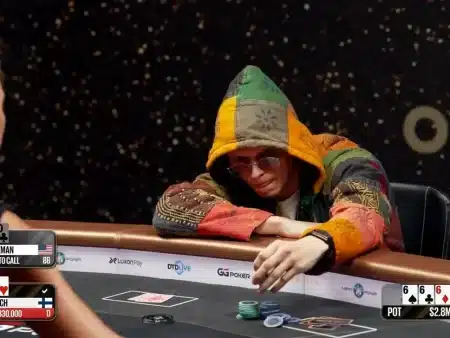Online poker isn’t what it used to be. In 2025, if you want to win real money, you’ll need sharper skills and a much better strategy than players did a decade ago.
The competition is fierce now that everyone’s got access to training tools and advanced techniques. It’s not just about luck or catching a hot streak anymore.

To actually make money at online poker in 2025, you’ve got to nail the basics and pick up some of the advanced moves the pros use to stay ahead. Sure, luck still matters in the short term, but if you want to win over the long haul, you need to make better decisions and keep up with how the games are changing.
This guide breaks down ten strategies that really work in today’s online poker world. Whether you’re just starting out or you’ve been grinding for years, these tips can help you boost your win rate, manage your bankroll, and avoid the mistakes that eat up profits.
Understanding Online Poker Real Money in 2025

The online poker scene in 2025 is way more sophisticated than it used to be. There are slicker platforms, a ton of game options, and much bigger tournament pools.
Players now have access to some pretty advanced tools and security is tighter, so you don’t have to worry as much about shady sites.
Key Differences Between Online and Live Poker
Online poker is fast—really fast. You’ll see 60-80 hands per hour, which is wild compared to the 20-30 hands you’d get in a live casino.
That means more chances to win, but also less time to think. You’ve got to make decisions quickly.
The cards are dealt using random number generators (RNGs), and these get audited by third parties to keep things fair. You can’t lean on reading physical tells, but you can use tracking software to study betting patterns.
Serious players rely on this data-driven approach. It’s become a must if you want to keep up.
Multi-tabling is another online-only perk. Some pros play 4-8 tables at once, which can really ramp up your hourly earnings.
Popular Variants: Texas Hold’em, Omaha, and More
Texas Hold’em still rules the scene in 2025. It’s the star of most major tournaments, and prize pools can blow past $10 million.
The rules are simple, but there’s a ton of strategy, so it’s great for both newbies and seasoned grinders.
Omaha—especially Pot-Limit Omaha (PLO)—is catching on fast. With four hole cards, there’s way more action and the pots get huge. The hands can get pretty wild.
| Variant | Popularity | Skill Level | Typical Stakes |
|---|---|---|---|
| Texas Hold’em | Very High | Beginner-Expert | $0.01/$0.02 – $100/$200 |
| Omaha | High | Intermediate-Expert | $0.05/$0.10 – $50/$100 |
| Seven-Card Stud | Medium | Advanced | $1/$2 – $30/$60 |
| Short Deck | Growing | Intermediate | $0.25/$0.50 – $25/$50 |
Fast-fold formats like “Zoom” or “Rush” are super popular now, especially if you’re short on time. You fold, and boom—you’re at a new table instantly.
Legal Landscape and Safe Online Gambling Sites
Where you live matters—a lot. As of 2025, 18 US states have legalized and regulated real money online poker. New York and Florida just came on board.
Legit sites have to use strict ID checks and responsible gambling tools. Always check for a license from a real authority, like the Malta Gaming Authority or UK Gambling Commission.
Security is tight on reputable sites. Look for at least 128-bit SSL encryption to keep your info safe.
Deposits and withdrawals are easier now, too. Most sites take crypto, credit cards, and e-wallets. Bitcoin is actually pretty common, and it’s fast with lower fees.
Building a Winning Strategy
If you want to win at online poker, luck alone won’t cut it. You need a strategy that fits today’s tougher games.
It’s about combining technical know-how with some psychological smarts, so you can make the best plays no matter what cards you’re dealt.
Proven Poker Strategies for 2025
The best players stick to the basics first. Studies show that consistent winners enter pots with a raise, not by limping in. That move puts pressure on the rest of the table.
Position is still everything. If you’re in late position (like the dealer button or cutoff), you get to see what everyone else does before you act. That’s a huge edge.
Early positions? Play tighter, stick to premium hands. Late position? Open up your range and get more aggressive.
Game selection is underrated. Don’t waste your time battling the toughest players if you don’t have to. Find softer tables and watch your win rate climb.
Bankroll management is non-negotiable. Never risk more than 5% of your total roll on one table. That’s just asking for trouble during a bad streak.
Bluffing and Reading Opponents Online
Bluffing online is a different animal. You can’t see faces, so you have to pay attention to how people bet and how long they take to act.
Quick calls usually mean weakness, while long tanks can mean someone’s got the goods—or they’re just trying to mess with you.
Some online tells to watch for:
- Weird bet sizes
- Timing changes
- Auto-play (like instant checks)
- Chat box chatter (or sudden silence)
Semi-bluffing works better than pure stone-cold bluffs. If you’ve got a draw, bet it hard—you might win the pot right there, or hit your hand on the turn or river.
HUDs (Heads-Up Displays) are a massive help. You can spot players who fold too much to continuation bets or who only 3-bet with monsters.
Position, Blinds, and Table Dynamics
Position is still the most underrated part of poker. Acting last lets you see how everyone else plays their hand before you put chips in.
Players in late position can profit with weaker hands, while early position is all about playing it safe with strong cards.
The big blind is weirdly profitable. You’ve already put chips in, so you can defend wider against single raises. But don’t get carried away—early position is where you want to be picky.
Your image at the table matters, too. If you’ve shown down big hands, people will give you credit and you can bluff more. If you’ve been caught bluffing, expect more calls.
Adjust your strategy by position:
- Early: Stick to the best hands, don’t get fancy
- Middle: Add suited connectors and strong broadways
- Late: Play more hands, steal those blinds
Adjusting to Opponent Skill Level
Against beginners, keep it simple. Value bet your strong hands—they’ll call with anything.
Bluffing is less effective because new players love to chase.
Against tougher opponents, mix things up. Don’t be predictable, and know when to let go of a good hand if the action gets weird.
The skill gap keeps growing. Intermediate players can get stuck between wild beginners and sharp pros. Tools like GTO Wizard can help close that gap, teaching you optimal strategies.
Check-raises are still a great move, especially against aggressive players who fire a lot of continuation bets. Sometimes just checking strong hands can really throw people off.
Mastering Bankroll Management and Risk Reduction
Bankroll management is the backbone of any long-term poker career. You can be the best player at the table, but if you don’t manage your money, you’re toast.
Setting and Sticking to Limits
Start by setting clear limits. Never risk more than 5% of your bankroll on one table—seriously, don’t do it.
For cash games, try to keep at least 20-30 buy-ins for your chosen stakes. It’s not glamorous, but it keeps you in the game.
If you’ve got $1,000, don’t play higher than $0.25/$0.50 with $50 buy-ins. That’s just common sense.
Most sites let you set deposit and loss limits. Use them. It’s way too easy to tilt after a bad beat.
Recommended Bankroll Requirements:
| Game Type | Minimum Bankroll |
|---|---|
| Cash Games | 30 buy-ins |
| Tournaments | 100 buy-ins |
| Sit & Go’s | 50 buy-ins |
Avoiding the Risk of Ruin
Risk of ruin is just what it sounds like—the chance you’ll lose everything. Even the best players go broke if they ignore bankroll rules.
Play within your limits. Only move up when your roll is at least 50% above what you need for the higher stakes.
Some players use a stop-loss—quitting for the day if they lose 2-3 buy-ins. It’s not a bad idea.
Track your wins and losses. Most poker sites have built-in tools, but PokerTracker gives you even more detail.
And for the love of all things holy, keep your poker money separate from your rent or grocery fund.
Managing Winning and Losing Streaks
Poker swings are brutal. Even the pros hit rough patches that last for thousands of hands.
When you’re running hot, don’t get greedy and jump up in stakes right away. Take a chunk of your winnings (maybe 20-30%) to grow your bankroll, but treat yourself to a little withdrawal, too.
If you’re losing, drop down in stakes for a bit. It’s not giving up—it’s just smart.
Review your play during bad runs, but focus on whether you made good decisions, not just the outcome. Everyone gets unlucky sometimes.
Take breaks, especially if you’re tilting. Emotional decisions will drain your bankroll faster than any bad beat.
Maximizing Casino Bonuses and Promotions
If you’re not taking advantage of bonuses, you’re leaving money on the table. The right offers can pad your bankroll and lower your risk while you’re figuring out the games.
Finding the Best Online Casino Offers
In 2025, there are more bonus deals than ever. Shop around before you sign up anywhere.
Sites like CoinPoker are offering up to 150% matches on first deposits right now, though you’ll need to clear those bonuses by playing a certain amount.
Look for:
- Deposit match percentages (100%-150% is pretty standard)
- Max bonus amounts ($1,000-$2,000 at the top spots)
- Wagering requirements (lower is always better)
- Expiration dates (longer gives you more time)
Bookmark bonus comparison sites—they update deals all the time. And keep an eye out for exclusive codes that bump up the bonus by another 10-25%.
Welcome Bonuses and Free Spins for Poker
Welcome bonuses are the main way poker sites lure in new players. Usually, it’s a matched deposit, so you get extra cash based on how much you put in.
The best poker welcome bonuses in 2025 offer:
- Match percentages from 100-200%
- Free tournament tickets to special events
- Free spins (mostly for slots, but hey, extra cash is extra cash)
Some sites split the bonus over your first few deposits, which can actually be a good thing if you plan to stick around.
Free spins are showing up more and more in poker welcome packages. You might not care about slots, but you can always use the winnings to pad your poker account.
Evaluating Fair Bonuses and Same-Day Payouts
Not every bonus is worth it. Always read the fine print.
Wagering requirements for poker should be 20x or less, otherwise you’ll never clear it.
Check for:
- Release increments (how much unlocks at a time)
- Time limits (30 days or more is best)
- Game restrictions (make sure your favorite variant counts)
- Max bet sizes while clearing the bonus
Fast payouts are a big deal, too. The best sites process e-wallet and crypto withdrawals in just a few hours.
Before you deposit, see what other players are saying about payout speeds. Watchdog sites and real reviews are your friend here.
Navigating Game Selection for Poker Success
Game selection is honestly one of the most crucial decisions you’ll make. The right game can make or break your profits—especially now that the player pool is tougher.
Choosing the Right Game: Cash Games, Tournaments, and Sit & Go
Cash games are super flexible. You can jump in and out whenever you want, which is great for bankroll management.
Experts say you should have at least 30 buy-ins for your chosen cash game stakes. It sounds conservative, but it saves you from going broke.
Tournaments are high variance but offer the chance at big scores. You’ll need a bigger bankroll—100 buy-ins or more—to ride out the swings.
Sit & Go’s are quick, with fewer players. They’re perfect if you don’t have hours to kill but still want that tournament feel. Just remember to play tight early and ramp up the aggression as blinds go up.
Pick the format that fits your skills and personality. Analytical types might love cash games, while adrenaline junkies might thrive in tournaments. There’s no one-size-fits-all answer—try a few and see what feels right.
Progressive Jackpots and Specialty Variants
Specialty poker games like Omaha, Stud, and mixed formats tend to have less competition. Not as many players really master these, so if you’re up for learning something new, there could be some real profit in it.
Progressive jackpot poker is a twist on the usual game, blending classic poker with ever-growing prize pools. Usually, you need a special hand or a particular sequence to snag the jackpot. Sure, your odds are long, but that extra thrill is hard to beat.
Some sites roll out unique versions like Fast-Fold poker. Here, as soon as you fold, you’re bounced to a new table and new hand. It’s fast-paced, lets you play a ton more hands, but you’ll need to tweak your strategy a bit.
If you’re checking out these games, pay attention to how tough the competition is—and don’t forget the rake. Even the most exciting format won’t be worth it if the house is taking too much off the top.
Exploring Video Poker Options
Video poker is kind of a hybrid: part poker, part slot machine. Jacks or Better and Deuces Wild are the classics, each with their own quirks and best strategies.
Jacks or Better is probably the simplest. You just need a pair of jacks or higher to win. With perfect play, the return can hit 99.5%, which is honestly one of the best deals you’ll find in an online casino.
Deuces Wild is a little crazier—all twos are wild, so you get more ways to win. Sometimes, if you find the right machine, the returns can even top 100% (though, let’s be real, that’s getting rare these days).
When you’re picking a video poker game, don’t get distracted by flashy graphics. Instead, check the pay tables. The best Jacks or Better machines are known as “9/6″—that means nine coins for a full house, six for a flush.
Unlike regular poker, in video poker you’re playing against the machine’s paytable, not other people. There’s no bluffing, but you do need to be sharp with your math and decisions.
Essential Poker Hands, Terms, and Rules
If you want to get good at poker, you’ve got to nail the basics: hand rankings, the lingo, and a bit of table etiquette. These are the building blocks, whether you’re at home or in a packed casino.
Understanding Poker Hand Rankings
Poker hands go from strongest to weakest. The top dog is the royal flush—A-K-Q-J-10, all the same suit. It doesn’t get better than that. Next up is the straight flush, which is just five consecutive cards in the same suit.
Then you’ve got four of a kind (pretty self-explanatory), and the full house—that’s three of a kind plus a pair. A flush is five cards of the same suit, and a straight is five in a row, any suits.
Three of a kind beats two pair, and two pair beats one pair. At the bottom? Just a high card—no combos, just your best card.
Watch out for the inside straight—that’s when you need a specific card in the middle to complete your straight. It’s a lot harder to hit than an open-ended draw, so don’t chase it too often.
Key Terms: Ante, High Card, and More
The ante is a small bet everyone throws in before any cards are dealt. It builds the pot and keeps the action moving.
If two players have the same type of hand, the high card breaks the tie. For example, an ace-high flush will always beat a king-high flush.
A few more terms you’ll hear all the time:
- Pot: All the money up for grabs in a hand.
- Blinds: Forced bets from the players to the dealer’s left.
- Call: Matching the current bet.
- Raise: Bumping the bet higher.
- Check: Passing the action without betting.
- Fold: Tossing your cards and giving up on the pot.
Where you sit at the table—your position—matters a lot. Acting last gives you a big edge, since you get to see what everyone else does before you make your move.
Live Dealer and Online Poker Etiquette
Live dealer games blend the ease of online play with something close to the buzz of a real casino. There’s an actual human dealer on video, which honestly makes things feel a lot more legit.
If you’re jumping into online poker or live dealer games, there are a few etiquette basics worth keeping in mind:
- Try to act promptly when it’s your turn—nobody likes waiting forever.
- Skip the ALL CAPS typing; it just comes across as shouting.
- Don’t go after other players for their choices, even if they’re wild.
- And yeah, it’s best not to talk about hands that are still unfolding.
When you’re in a live dealer game, give the dealer the same respect you’d show in person. They’re running the show, just from behind a screen.
A lot of skills cross over between poker and card games like blackjack, sure. Still, poker’s mix of strategy, reading people, and working the odds? It’s a whole different beast.













